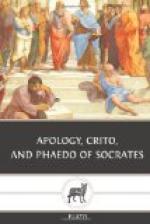“Indeed, Socrates,” said Simmias, “we should be very glad to hear that fable.”
136. “First of all, then, my friend,” he continued, “this earth, if any one should survey it from above, is said to have the appearance of balls covered with twelve different pieces of leather, variegated and distinguished with colors, of which the colors found here, and which painters use, are, as it were, copies. But there the whole earth is composed of such, and far more brilliant and pure than these; for one part of it is purple, and of wonderful beauty, part of a golden color, and part of white, more white than chalk or snow, and, in like manner, composed of other colors, and those more in number and more beautiful than any we have ever beheld. And those very hollow parts of the earth, though filled with water and air, exhibit a certain species of color, shining among the variety of other colors, so that one continually variegated aspect presents itself to the view. In this earth, being such, all things that grow, grow in a manner proportioned to its nature—trees, flowers and fruits; and, again, in like manner, its mountains and stones possess, in the same proportion, smoothness and transparency, and more beautiful colors; of which the well-known stones here that are so highly prized are but fragments, such as sardine-stones, jaspers, and emeralds, and all of that kind. But there, there is nothing subsists that is not of this character, and even more beautiful than these. 137. But the reason of this is, because the stones there are pure, and not eaten up and decayed, like those here, by rottenness and saltness, which flow down hither together, and which produce deformity and disease in the stones and the earth, and in other things, even animals and plants. But that earth is adorned with all these, and, moreover, with gold and silver, and other things of the kind: for they are naturally




